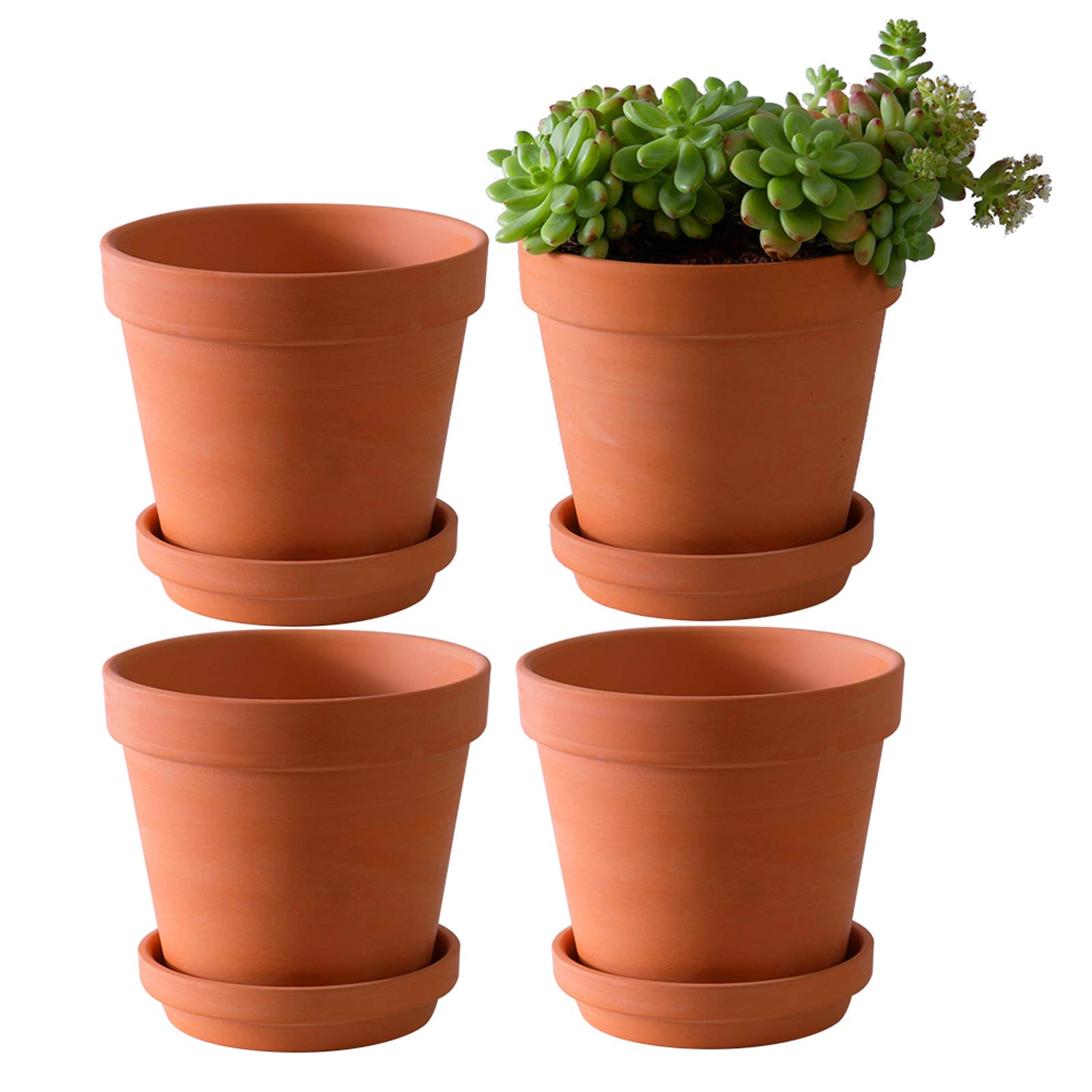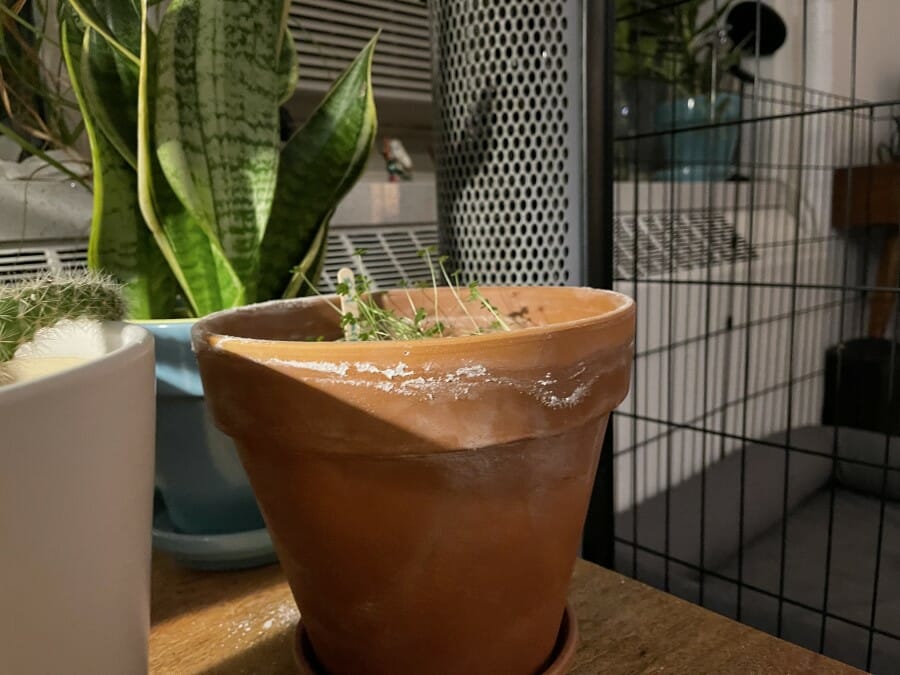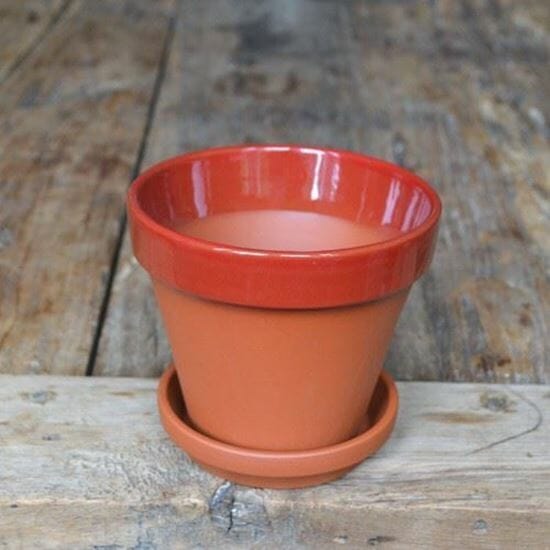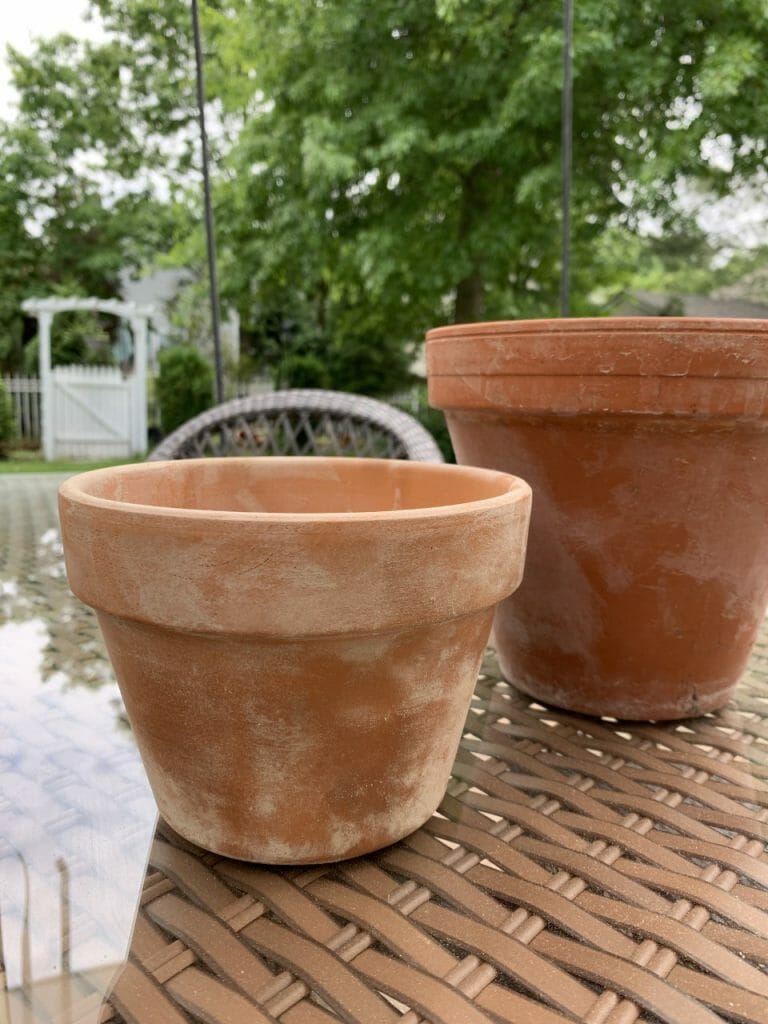If you are a gardening freak, your space must be filled with terracotta pots with green beauties of all kinds inside them. Terracotta pots are beautiful, and the reddish-brown earthy color provides comfort and serenity due to its simplicity. However, after some time of usage, white mold appears on terracotta pots affecting their beauty. And like every other material, terracotta also needs maintenance. But the good thing is that they are low-maintenance pots, and you can recover their beauty by just following simple steps.

This article will provide a complete guide on why this white residue appears and how you can eliminate it.
1. Terracotta Pots – A Popular Option
Traditional terracotta pots are popular among plant lovers as they are gorgeous and easy to use. But the color is not the only reason to like them. People prefer terracotta as a material for plant pots due to its other outstanding characteristics.

- They are highly porous and permeable. Unlike plastic pots, the clay-based structure of terracotta pots allows moisture and fresh air to pass through them quickly. Hence the roots get enough nutrients and water to grow without any overwatering.
- These pots are budget-friendly and less-expensive options. Although they are affordable, they do not look cheap.
- Being made from natural clay instead of synthetic materials prepared after excessive processing, the terracotta pots are certainly an environment-friendly addition to the garden.
- These clay pots are certainly aesthetically pleasing since they give more of a natural look to the plants.
- The customization of terracotta pots is easy. If you are bored with your indoor interior, you can paint a few pots and see a visible difference in your space.
- The moisture-absorbing quality is also beneficial for the winter season preventing continuous moisture exposure to the soil and roots.
Also Read: 6 Amazing Benefits of Terracotta Pots
2. Why my Terracotta Pots Are Turning White?
You may have noticed a white crystal residue on your terracotta pots. This does not make your plant look appealing. Since terracotta is porous, water drains out from it quickly. Similarly, it can absorb moisture from the soil. These useful characteristics of terracotta pots also serve as a risk factor for getting 1) Efflorescence or 2) Mold invasion on them.
2.1. White Residue Buildup on Terracotta Pots
When we water the plants, the moisture evaporates. However, the terracotta absorbs the salt, minerals, and calcium in the water. The residue, known as efflorescence, accumulates on the surface of the container in a white chalky powder form. It is an entirely natural process and does not harm the plant or pot. You can find this residue build-up near the drainage holes or on top of the soil itself.

2.2. White Mold Growing on Terracotta Pots
Due to poor drainage in the pot, the soil remains damp. Hence with moist soil, the risk of mold also increases. The mold often seen on terracotta pots is a saprophytic(spore-bearing) fungus giving it a white or sometimes blackish covering.
2.2.1. Reasons for mold formation:
- Humidity:
A humid and moisturized environment is the most favorable one for mold growth. Since the terracotta pots absorb maximum moisture, the 24/7 moist pores of terracotta pots serve as an excellent medium for white mold growth.
- Frequent Watering
Frequent watering required for some plants in terracotta pots (as mentioned above) also contributes to white mold growing on terracotta pots.
- Lack of proper sunlight
Another contributing factor to mold growth on pots is the lack of proper sunlight. The water remains within the pot without sunlight, causing white mold to grow in terracotta pots. Hence sunlight should be monitored while placing your pots.
2.3. Is It Mold or a Mineral Deposit?
Mineral or salt remains, also called efflorescence and white mold growth, have a somewhat resembling appearance. Before digging into the solutions and preventions for white mold growing on terracotta plants, it is essential to find out if the white powder on the pot is efflorescence or white mold. To avoid confusion and all the resultant hassle, first, confirm that the whitish growth on your terracotta pots is white mold and not simply a mineral deposit by the following tips:
- While looking carefully at the growth, if you find something velvety or fuzzy white, then it is mold growth.
- Scraping the fungal growth off will quickly shed; however, mineral deposits do not.
- The layer of white mold is usually thicker and raised compared to the mineral deposit.
- Mineral deposits show a variation in color, i.e., somewhat white and yellow.
- White mold’s growth pattern is somewhat circular compared to mineral deposits’ uniform distribution.
3. White Mold on Pots is Harmful to Plants?
If you are new to plants, you may panic the first time you notice the white mold growing on terracotta pots. However, there is no need to worry. The white mold will not invade and affect the plant’s growth, especially when it has just appeared on the pot. While the white mold you see on the pots will not cause the death of your plants, it may still damage the plant in the long run.
Moreover, it can also be harmful to you. This is because the saprophytic fungus is contagious and can spread to the human body through continuous exposure. Therefore, getting rid of these nasty growths is vital as a preventive hygienic measure.
Lastly, the pots with white mold do not look appealing. And you do not want to affect the interior of your space by placing these pots covered with white decay.

4. 3 Solutions for White Mold on Terracotta Pots
There are a few solutions to destroy the white mold in your pots.
- Hydrogen peroxide
A 3% hydrogen peroxide solution can do wonders when getting rid of that nasty white mold growing on terracotta pots. It is a weak acid that is an effective fungicide in its protonated(solution) form. For cleaning, take a spray bottle and fill it up with 3% hydrogen peroxide solution. Start spraying in a circular motion until the whole pot is covered with the solution.
Allow the pot to sit for at least 15-20 minutes with hydrogen peroxide solution on it. You might notice the sputter due to the acid-mold interaction. Then use a separate kitchen sponge, scrub, or a spare toothbrush to scrape all the growth off the pot. Instead of spraying, the pots can also be left dipped in water and hydrogen peroxide solution if you have got them empty for cleaning. In the end, you might want to rinse it off with clean water and let it dry In direct sunlight for a while. Your port is now completely clean.
As a preventive measure, you can leave some solution sprayed on the outside of the pot if you want.
- Bleach solution
The second and comparatively harsh option you can use is bleach. It is usually a diluted solution of sodium hypochlorite (a discoloring agent) used for various purposes. Take bleach and water in a 1:20 ratio to clean the white mold growing on terracotta plants. Fill it up in a spray bottle. Since bleach is a strong agent, we recommend taking out the plant and keeping it temporarily in another container until you clean the pots.
Spray the solution generously inside and outside the pot for complete coverage. Then clean the pot with tap water at least 2 to 3 times to ensure that all the bleach has been rinsed off. After this, let the plant air dry for a few days until all the bleach remains are gone. Now you can place the plant again in the pot, which is good to go.
- Dishwasher and Neem Oil
Neem oil is a natural fungicide. To make a solution, take a container and mix four tablespoons of the dishwasher with the same amount of neem oil in some water. Dip the sponge into it and gently clean the whole pot. It cleans the pot and seeps through it into the soil for future protection.
This is all you need to do to eliminate that white mold growing on terracotta pots.
5. How Do I Prevent White Mold in My Pots
Here are some tips to help keep the mold away from the terracotta pots.
- Proper Sunlight:
Ensure proper sunlight exposure for the plants. Direct sunlight is a great way to prevent mold. Moreover, it also kills any mold growing in the pot. You can provide sunlight to your indoor terracotta pots once in a weak to maintain their beauty.

- Good Drainage
Since terracotta is porous, it absorbs water and moisture from the soil. The moist soil is at significant risk of mold growth. So, to prevent mold in your pots, you must ensure good drainage. If the pot’s drainage is poor or the holes are blocked with soil, it will keep the bottom of the pot soggy.
- Avoid Overwatering
The biggest mistake that beginners make is overwatering. Most of the plants prefer to be watered when the soil is dry. If you keep watering the plants without the soil being dry, it will lead to mold formation and other problems. Overwatering is never a healthy factor for the plant’s growth. So, to prevent mold growth, you need to avoid unnecessary watering of the plants, only water when the soil is dry enough.
- Avoid Humidity:
Humid conditions are the most favorable for originating fungi and mold. A porous pot that absorbs moisture in a space with a high humidity level is a perfect combination for the mold to thrive. Try to keep the pots away from humidity to avoid favorable conditions for mold growth.
- Remove Dead Foliage:
Fungi also grow in the dead leaves that accumulate in the upper portion of the soil in the pot. With other conditions like humidity, the foliage helps in the growth of mold and fungus quickly. You can also prevent and stop the spread of fungi if you remove the dead foliage in time.
- Improving Ventilation:
If you live in a humid area, then the risk of mold growth on pots is higher. However, you can control and prevent mold growth by improving ventilation and maintaining adequate air circulation.
- Glazing Pots:
Terracotta pots are usually non-glazed. By sealing the pot, you can protect it from environmental conditions that are favorable for mold growth. Therefore, glazing the unglazed pots is a good option to make them look new and clean, keep in mind that glazed pots are not very porous, so you must take care while watering the plants.

Also Read: 10 Best Indoor Terracotta Pots for Your Plants
6. Conclusion
We hope this article will help you solve the white mold problem in your terracotta pots. Moreover, with the prevention measures, you can also limit mold growth in the pots.
If you liked this article, please leave a comment below. And visit our website for more articles related to plants and planters.
7. Frequently Asked Questions
1. What is the white stuff growing on my terracotta pots?
The white chalky residue on the terracotta pots can either be mineral deposits or white mold. Although they have a resembling appearance, you can differentiate them easily. If the white residue appears in flat patches and feels solid on touching, it is simply salt and mineral deposits from the hard water. However, if the white stuff is slightly raised on the pot and feels fluffy when you touch it, the white mold is growing on your terracotta pot.
2. Why are my terracotta pots growing mold?
Moisture is the main factor in mold growth. Since terracotta is porous, it can absorb moisture. If the environment is humid, there is poor drainage in the pot, lack of sunlight, and overwatering, then the water remains in the soil. The moist soil can create an ideal environment for mold growth.
3. Is mold on terracotta pots safe?
The white mold is not harmful to the plants, but it is better to wash the mold. Because if it goes unnoticed, it can cover the plant’s roots, waterproofing it. So, the roots will not be able to absorb sufficient water leading to dehydration, which can be fatal for the plant.


